D.V. Gutman - 1000 Miles Up The Amazon with the Booth Line
|
D.V. Gutman - 1000 Miles Up The Amazon with the Booth Line |
| This is a reconstruction of a
typical journey made by the Booth Line ships Hildebrand and Hillary in
the 1920s and 1930s based on the photograph album of D.V. Gutman the
ships photographer, with an accompanying narrative
from the diary of passenger Henry
Balfour, the period travel book written by Ardaser Sorabjee Wadia and the memoirs of Trevor
Stephenson. See links.
Currently only the material relating to the journey description is shown. |
||
| Day 1 July 12th |
Visited Liverpool museum in the morning and saw the Pacific collection and had a talk with the Curator. Sent my luggage down to the Quay from Lime Street Station and walked down. The "Hildebrand" (148) was not yet alongside, but came in at about 3 p.m. Boarded a little before the arrival of the crowd coming by via the charter train from London. Found my cabin No. 54 on main deck had been changed for a much better one No. 39 on the upper deck. Excellent, roomy cabin for two all to myself. We cast off at 4 p.m. exactly, with gramophone blaring away making an awful din. Exiting the River Mersey past the lighthouse and little Fort at Perch Rock the ship proceeded along the North Wales coast and after passing the Skerry Light we put into Holyhead just to drop the pilot.Weather dead calm but slightly foggy. |
|
| Day
4 July 15th |
Arrived at Leixões in Portugal at about 9 a.m. Went ashore with a party of passengers and motored to Oporto. Some of the private and public gardens are very attractive with fine displays of hydrangeas, hibiscus etc. Many bullock-carts on the roads with wheels and axles revolving together carts have huge elaborately carved yokes of rectangular form. Visited the fruit and fish market, where Baracutas and Octopus were largely for sale. Went inside a now derelict and disused church the whole interior of which is elaborately carved with gilt woodwork and a 'Tree of Jesse' in complete relief. It is rapidly falling to bits. Then we drove over a bridge (454) spanning the gorge of the Douro; with double roadway (high and low levels) quite spectacular. Fine view of Oporto from the other side of the bridge (Villa Nova side) (452) and good view of the river far below (455). Visited over a Port wine factory of Hunt, Ruope and Co, saw the Port stored in huge vats and barrels. The cooperage and the barrel making process was interesting, sampled various dark and white ports. Lunched at the "Crystal Palace", where the gardens contain a few animals (leopards, wolf, red deer and various breeds of dogs). Motored back to Leixoes. The roads are awful and very dusty. We sailed at about 6 p.m, very foggy at first and quite calm. The fog cleared at night. |
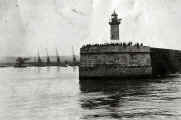 |
| Day
5 July 16th |
Arrived at Lisbon (154) (450) about 7.30 a.m. The ship anchored in the Tagus (442) near where it widens out into a wide lagoon. Went ashore and joined a motor excursion to a very pretentious villa in a fine garden with horrible sham grottoes etc it was a medley of misspent money and bad taste. Then on to Cintra and the Palacio Real (440) (449), 14th-15th century. Interior interesting though not very specially so. Next up to the Castello da Pena on top of a fine granite ridge. Very fine view and some interesting architectural features. Back to Lisbon via the Estoril, "Portuguese Riviera". Went on board at 4 pm. Weighed anchor about 6 pm.Absolutely calm again and foggy at
first. |
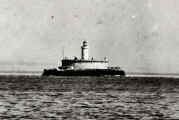 |
||||
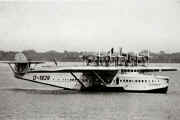 |
| Day
6 July 17th |
At sea its fine, warm but with cool breeze, very little motion from the ship. Very little signs of anything in the vast expanse of ocean. |
| ' |
Anchored off Funchal in Madeira at 7.30 am (459). Went ashore with Bryant, Gutteridge and Stewart by launch to Reid's Hotel landing (462) and up the cliff in a shaky lift to the hotel. Garden is very nice with an abundance of flowering hibiscus, bougainvillea etc . At Reid’s we took a car to top of a low hill for a fine view all round (137). Back to Reids and I had a walk round the hotel (456) (457) until lunch at 12.30. Lunch quite good. Gardens all round pretty luxuriant with lots of colour. Vines coming on very well. Jacarandus plumbago, bougainvilleas, geraniums flourishing. After lunch we drove to the town (461), visited the fruit and fish markets. Parrots, macaws and other birds for sale in the markets. 'Espadas' seem the chief fish sold; long, ugly, black and slimy fish, but not bad to eat; with thin bodies tapering from a large head with goggle eyes to an almost finless tail. Thin black skin is scraped off, leaving them pure white. Barracuta also for sale (striped like pike), wrasse, Grey mullet and other scale-fishes, octopus etc. We called on 'Maria', a red macaw of great age and then spent some time in the small public garden. Frangipani in flower; many palm varieties, tree-ferns; pandanus and pomegranates in fruit; hibiscus, strelitzia etc. in flower. Went on board about 2.30 pm and sailed at 3pm. Gulls followed the ship. Hot night. |
|
| Day
8 July 19th |
At sea, calm with N.E. trade wind and S.W. course. A few pelagic petrels, many flying-fish. Sun slightly overcast. Ship rolling towards evening. Heat not oppressive especially on the port side. Lecture by the Doctor after dinner, on the Amazon, nothing new however; some slides. |
|
| Day
9 July 20th |
Ship now rolling fairly heavily with a following wind, fine and not too hot, except in dining saloon. A few flying fish spotted. |
|
| Day
10 July 21st |
Same as yesterday. Rolling, stuffy. Spotted some flying-fish again. Cooler later with wind on port beam. |
|
| Day
11 July 22nd |
Overcast at first but sun came through later. Rolling, stuffy atmosphere. Flying fish. Somewhat cooler on deck. No flying fish during afternoon. |
|
| Day
12 July 23rd |
At sea. Fine; little breeze but moderately cool. Calm sea. One Portuguese man-of-war reported seen, otherwise only flying fish and these scarce. |
| Day
13 July 24th |
Fine, but heavy clouds in late afternoon and a fresh Southerly breeze. Hot and stuffy down below. A small all dark petrel seen early in morning. A large school of dolphins or small whales lazing on surface, and a bonito seen. Passed close to the "Aidan" (Booth Co.) at 7.30 a.m. |
| Day
14 July 25th |
Fine and calm with coolish breeze on port side. Crossing the line ceremony at 3pm. (295) Amusing and elaborately done (260) (300) (278) (288) with help of the canvas swimming tank into which all neophytes were tipped backwards. (294) Captain says that whales are very rarely seen in this latitude.
|
 |
| Day
15 July 26th |
Calm; cool breeze from S.E. Very hot below. No life seen except two very white birds and flying fish. Equator crossed about midnight. Hot night in cabin. Wadia 'The ship moved not an inch from dead centre for nine days continuously. The tedium of this long landless voyage of twenty two hundred miles would have assuredly told on our spirits and possibly our tempers as well, had not the bathing-pool (263) and cool trade-winds, the deck-games (330) (695) and the evening entertainments (303) come to our assistance and helped kill time.'
|
|||||
|
| Day
16 July 27h |
Picked up pilot off Salinas about 3 a.m. (418) Raining. Entered the Pará Estuary long before breakfast. Both banks visible though distant; heavily jungled. Picturesque fishing boats (542) with coloured sails. Urubus (vultures) visible in quantities flying about the shores. A few dolphins. Dense jungle everywhere broken by clearings and near Pará, by groups of residences. Slight mirage effects. Arrived at Pará at about 10.30 a.m. and tied up to a wharf. Did not go ashore till 3.30pm, to escape the heat which was considerable. Then I went with Bryant, Gutteridge and Stewart for a motor drive (548) (380) (381) to the Bosqué (376) (377) (378) (379) (a preserved area of natural jungle) that lay some way beyond along a partly made road. Passed a garden with some large egrets, a very fine heron, a smaller dark mottled heron (or bittern), some toucans and troupials (yellow+black) etc. In the gardens and parks, many varieties of palms, pawpaws, breadfruit trees and mangoes, silk-cotton trees (sucuruma) with great buttressed stems. Erythrina (?) in flower, white and red frangipani in flower, cycads, hibiscus, cacao, hevea braziliensis etc. We returned to the Grand Hotel for a drink, and I went back there to dine with Mrs. Kingdon and Miss Randall. Not very good. After dinner I went with them, Mrs Lloyd and Mrs Pollock, to the adjacent theatre (619), where a very poor musical comedy was played. Voices execrable and acting mostly poor. We stood two acts and then left, went back to the ship. Very sultry night in cabin, awfully stuffy, with mosquito screens over port hole and door. |
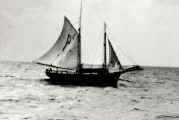
|
|||||
|
| Day
17 July 28th |
A group of us went to the little English church, ( 207) (632) where is a gunmetal tablet to Bates, Wallace etc. A Booth Line employee remarks about the church. One day Bishop Evans of the Falkand Islands arrived to inspect the English church which was run by Padre Moss. The latter was an old time resident who earned a little extra selling paintings of moths and butterflies to tourists on the "Hildebrand and the Hilary". Later in the morning we went to the Zoo which is quite good, though small; all the beasts (604) and birds (605) seeming very healthy and in excellent state. All local except a chimpanzee (600). In the afternoon I went back to the Zoo (121) (396) (397) (398) (410) and Goeldi Museum (639) + spent some time there by myself. Dined at the Grand Hotel. |
||||||
|
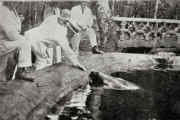 |
| Day
18 July 29th |
Pará. Spent the day
looking around in general (116)
(587) (210) (620)
(641) (547) (644).
Dined at Grand Hotel with Mrs. Lloyd, Mr. Pollock, and went on board at 10 p.m. Anchor weighed at 11 p.m. Nice cool breeze for a few hours steaming Eastwards before turning W. towards the Narrows |
Para, Belem Harbour Now |
|||||
|
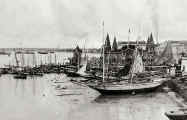 |
| Day
19 July 30th |
In rather narrow waters, jungle grown on both sides and heading for the Narrows which we reached at about noon. This channel, joining the Amazon and the Pará Estuary (Tocantins) is mostly very narrow and densely jungled with caboclo huts at intervals (190) (314), but only slight clearings. Was on deck by 6.15 a.m. and saw large and small Egrets, light-coloured herons and large heavily built yellow billed Terns. The native huts are mostly of palm leaf and built on piles (140). A stem of Mirité palm forms a landing pier over the sloping muddy bank. Canoes (montaría) are either dug-out or sometimes plank built either open at the two U-shaped ends, or filled in with triangular pieces of wood (677). Watermanship even of quite small children is wonderful. The paddles are very broad-bladed with crutch handles. Sometimes pointed. Hammocks used for sleeping. Pale-copper coloured Indians (Tupi) + half breeds + mixtures of all kinds. Reached Brévés, a small settlement, at about 1.30pm. At about 4pm we passed the narrowest part of the channel which leaves little room to spare (481) (615) (629). Heat mitigated by coolish breeze on starboard side. |
||||||
|
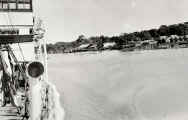 |
| Day
21 Aug 1st |
Passed Santarem about 12.30 a.m. Did not turn out to see it as only lights could be seen at a distance. On deck by 6 a.m. just before sunrise. We had passed Obidos at about 5.15. Low red cliffs on left bank, then jungle with open spaces + lagoons. Had an excellent view of an alligator (jacaré) floating high in the water. Saw many Indians in small canoes shooting fish with bow and arrow (516). The arrows are long with detachable heads and retrieving lines. At about 12.30 we passed the boundary between Pará and Amazonas states. Wide reaches free from floating masses of camarana grass, which till then had been very abundant. The jungle is lower than further down the river. In afternoon large clearings turned into grazing land with good herds of cattle (mixed European + Indian humped breeds). Saw a Jacana fly from a floating camarana patch. Heavy rain.
|
|
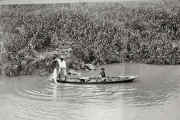 |
||
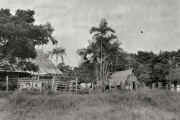 |
| Day
22 Aug 2nd |
Fine, partly overcast. Banks more inhabited and cultivated with some large cattle-grazing areas. Palms few but more than yesterday. Bombax (silk cotton) abundant and in pod. Many banana plantations. Natives fishing with bows (517). Jungle rather open. Passed a small, primitive light house at 11.30 am (656). We crossed the sharp line where the ‘black’ water of the Rio Negro join the yellow Solimoês Amazon without mingling, at noon. Passed the Leper Hospital on a low red cliff soon after; and reached Manáos (614) at about 12.30. Not very attractive looking from the river (Rio Negro) (526) (630). We tied up to a huge pontoon, forming a detached quay. Numbers of urubus flying overhead; swallows large yellow-billed Terns. Went ashore at 3pm with the Varsity contingent to be received by the Governor of Para (+acting President of the State of Amazonas), Señor A. Monteiro de Souza, at the Palace. Genial old boy, speaking mixed French and English. Drinks and coffee served round and then he showed us his collection of live animals (a Capybara, agouti, 2 kinds of jungle deer, horned + hornless – 2 Trumpeters, Curassows, Shelducks, a pheasant of some kind with red wattle, 2 Thickknees, etc) The Governor then took us in 3 or 4 Government motor cars round Manaus to see the town (544) (358) (613) buildings, schools etc. I drove with him. We finished up at the brewery, a very large, prosperous looking building, where we were entertained with excellent beer by the Manager. Although there are few breweries in Manaus, this is one the most popular. It is owned by Miranda Correia & Cia and produces three main types of beer, Cerveja Amazonense, Cerveja Sublime & Cerveja XPTO.Back to the ship at 6.30 for dinner. It rained in the evening with much lightening. |
|||||
| Day
23 Aug 3rd |
Overcast and threatening rain in the morning. The party (520) went on board a small steamer (663) at 9 a.m. some way up the Rio Negro (1 3/4 hours) (575). Arrived at the Igarapá Tarumá , we changed into a smaller launch (246), towing several boats (505), into which we got on arriving at the edge of an extensive igapó (flooded forest) (243) (119). Through this we went in the boats, forcing our way through the tree trunks and stems of llianas etc (241) (488). A wonderful, fairyland scene somewhat spoiled by heavy rain and lack of sunlight. The vegetation very fascinating with forest-trees, palms, climbing plants in great variety. Many of the palm stems were densely thorn studded. Immense ants’ nests (510) were abundant on the trees; often very high up and near the tops. Huge wasps’ nests hung from many trees; and some small beautifully formed wasps’ nests were seen hanging from branches. Several birds were heard calling, but could hardly be seen in the dense growth. I heard some Squirrel Monkeys chittering. After a time we reached the Tarumá Fall, Alta do Tarumã (511) (413), a small but picturesque fall of amber-coloured water falling vertically. Some of us scrambled over the rocks to the foot of the fall (489) (130) (596) and also up the steep ravine side to the top (233) (563) . The water above the fall is of the deepest amber colour, very remarkable. The Tarumá is quite a small stream running through dense jungle. I got very wet from the rain, in spite of a ‘waterproof’. We returned the same way through the igapó , and were then towed in the boats by the launch to the steamer (688), which we reached at about 2 p.m. We had lunch on board on
the return journey to Manaós, reaching the "Hildebrand"
soon after 5 p.m.
|
|||||||||||||||||||||
| Day
24 Aug 4th |
The Governor of Manáos (acting President of the State of Amazonas), A. Monteiro de Souza, claimed the University contingent for the day, and he turned up in his launch unexpectedly at 6 a.m., accompanied by the Chief of Police (R. Gomes Nogueira), the Mayor of Manáos, Dr. J. Ribeiro and his wife and daughter and some other people. We, of course, were not ready for so early a start [I was in my bath and others were not even up]. But we got together by 7 a.m. and went to the launch with profuse apologies to the Governor, who however was not much upset by the delay. He took us in the launch down the Rio Negro and turned into and across the Solimões (Amazon) and up some of the paranás (channels forming islands), passed some cultivated areas and grazing lands with wooden or palm-leaf houses built on piles (as it is within the flood area). We saw some small huts built upon rafts, moored so as to rise and fall with the water, these are lived in by petty traders, who use them as bases from which to trade in canoes. Many tucuxi and other fresh-water dolphins were seen, especially in a small bay near the mouth of the Rio Negro (right bank). We transferred to small boats at one place (247) to visit a lagoon (514) (515), to see the Victoria Regia lilies, which are abundant in the still lagoons (616) (527) (628) (468). These were not at their best, it not being the season, but there were plenty of the floating leaves, 3 to 4 feet across, with upturned edges, and some very prickly buds, though no open flowers. A very beautiful lagoon, surrounded by jungle. (470) We next went to Dr. Jeronymo Ribeiro’s bungalow (179) (332), "Somé", at Cambixe, on a small paraná, where an elaborate lunch had been prepared, under a dense clump of bamboos on the bank of the paraná. While there, I was presented by Miss Ribeiro with a magnificent macaw (arára, Ara macao), which a girl friend of hers had on her wrist (249). A somewhat embarrassing gift but a very beautiful example, and quite tame. We went round part of Dr Ribeiro’s property and looked at his crops of bananas, cacao etc. and stayed some time after lunch smoking, talking and photographing (238) (246) (247) (365) (374) (484) (498) (573) (593) (594). We returned to Manáos by the same route, slightly modified. The dolphins were still fishing in the little bay near the Rio Negro mouth. We passed some tugs towing 30 or 40 montarias (170) (189) (small boats or canoes) apiece, on their return down river from trading. After a splendid, sunny day, we got back to the jetty at Manáos at about 5.30 pm. I took the macaw on my wrist + marched to the ‘Hildebrand’, making a somewhat sensational entrée on board. I deposited the bird with the butcher. |
||||||||||||||||
| Day
25 Aug 5th |
In the morning, I looked about Manáos with Salt and Hargreaves. We went into the Cathedral, which is not particularly interesting, but has a fine approach with double, converging sets of very wide stone steps (101) (431) (436). We also went round the fruit market (113) which is quite interesting. In the afternoon, Gutteridge, Harvey, Hargreaves, Roget and I took a motor-car and went out along the new road (eventually destined to reach Guiana), past Flores through jungle and as far as Campos Salés where the road is alongside the Tarumá river. I looked around in the jungle which is pretty dense. The road beyond this was under construction, but the car was able to get over it and we eventually reached the top of Tarumá Fall (562), much to our surprise. I found some of the pot-like wasps’ nests, but did not succeed in finding any snakes, for which I looked. We got back at about 6 pm. At 10 pm some of us went to the English Club where a dance and "soirée blanche" had been arranged (104). There we met most of the resident English people and many Brazilians. I went back to the ship soon after midnight, leaving most of the others there. Salt and Mrs Lloyd came away with me.
|
||||||
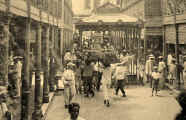 |
|||||||
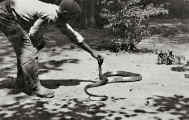 |
| Day
26 Aug 6th |
The ‘Hildebrand’ dropped from the pontoon to the main jetty early in the morning. At 6 a.m. I went off to the fish and fruit market (222), which is in full swing early in the morning. Many varieties of fish were for sale – pirarucuperanha, some varieties of armour-plated fish, etc. etc. There were hundreds of urubús hanging round the outskirts of the market and scavenging. When I got back it was to a busy scene on board and on the jetty (206). Many people came on board to say goodbye – including Taylor, his son and Miss Rolfe (who was going far up the Madeira in a stern-wheeler, for a two-years job) (536). The Governor’s military attaché also came and I said goodbye to him and sent messages to the Governor, on behalf of the University contingent. Amid much waving, the ‘Hildebrand’ cast off at 10 a.m. and started the homeward voyage. Fine, hot, sunny day. We passed Obidos, a cheerful looking collection of houses and stores on a high bank (left, or N. bank). Oposite, near the other bank of the Amazon there was a group of 16 or 17 canoes, each with an indian fishing with bow and arrow (or harpoon-arrow). Hardly any floating vegetation (camarana etc.) seen on the broad reaches hereabouts, such as one sees so abundantly lower down the Amazon. Very fine sunset +, at night, a great deal of lightning, with rather more than a half moon, giving a very fine effect of colour.
|
||||||
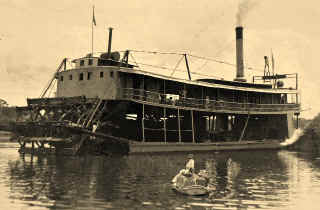 |
|||||||
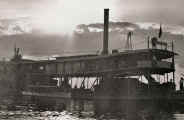 |
| Day
27 Aug 7th |
Up at 6 am, to find the sky heavily overcast with rain, thunder and lightning. It had turned cold during the night and I had to shut off the fan in my cabin at 5 a.m. The weather cleared during the morning. At 10.15 am. we passed Santarem, very prettily placed at the mouth of the Tapajos R. Quite a pleasing small township, mostly red-tiled. A sharp line marks the meeting of the ‘black’ water of the Tapajos and the yellow, opaque Amazon water (649), which is turgid with silt. This line is drawn right across the Tapajos mouth and extends for some distance along and near the right bank of the Amazon. There is a high-ground (a serra) at the back of Santarem, jungle-clad hills. The jungle was relatively low, but dense and open grazing areas were frequent near Santarem. Lovely sunny afternoon along very broad reaches, mostly quite free from flotsam. Vegetation in jungle very varied. The ‘Hildebrand’ only rarely was close to the river banks, as she keeps well out going down stream. It rained again a little in the late afternoon. We were passing the hills of the Serra Jutahy at about 6 p.m., a range of flat-topped jungle-clad hills. A very fine thunderstorm at night; lightning almost continuous, sheet and chain, covering a huge area. |
| Day
28 Aug 8th |
Up at 6 a.m. We were in the "Narrows" (615), which link the Amazon proper with the Pará Estuary, which is mainly an extension of the Tocantins. Brevés was passed at 12.30 p.m. and the "Narrows" were left soon after lunch. Coolish breeze in the evening, but it was still exceedingly hot in the cabins and saloon. We passed Mosqueiro, on the S. shore of the Pará estuary, at about 11.15 pm. and anchored at 1 a.m. some 4 or 5 miles East of Pará.
|
| Day
29 Aug 9th |
I went ashore at 9 a.m. and did some rather disappointing shopping. I spent £2-10-0 on Indian spears and arrows etc. for the Museum, but found little else of interest. Went on board for lunch and left again at 2 pm for the shore. I spent most of the afternoon at the Zoo and Goeldi Museum, having met Goulding with whom I visited the fine new R. Catholic Church. Afterwards Goulding and I went to the offices of the Para Electric Tramways Co. and saw J. Mansell (who had come out in the Hildebrand with us); the latter showed me his garden and gave me a very curious fern. He has a fine collection of varieties of crotons. After that I walked back to the centre of the town and looked about the streets and gardens. Dined at the Grand Hotel with some of the others, and went back to the ship by the 11.30 pm. launch, with Mrs Lloyd, Mrs Pollock and Stewart. |
|
| Day
30 Aug 10th |
I went at 9 a,m. with others in a large, three-decked river steamer down the Pará Estuary to Mosqueiro (114) (118) (198) (199), a small sea-side resort, reached in about 2 hours. We landed on a pier and transferred to two exceedingly primitive trams (200) (588), each drawn by two mules, and went along a vilely laid track (107) through jungle to (493) (625) Chapéo Virádo (474), a smaller village picturesquely situated along a shore with fine sandy stretches. Some of us bathed (187) (188) (162) (185), while I had a stroll along the coast. Few birds were to be seen, but I saw some palisade fish-traps, erected along the shore between tide-marks. We returned to Mosqueiro the same way in the trams. At a siding our tram’s front wheels jolted right off the lines and let us down with a crash . Giving us a good shake up. The car was eventually lifted back onto the lines and we passed on, but stopped to see how the other tram would fare and whether it would follow suit. It did, first the front wheels and then the back jumped off the track and crashed onto the sleepers. It, too, was lifted back onto the track and we managed to get to Mosquiero with only one more accident, to the vilely-driven second tram. The mules while pulling wide in trying to round a sharp curve, fouled an iron post, smashing the traces and detaching the mules. We walked from there to the pier! Great numbers of Urubús were scavenging along the shore. We lunched on board the river-steamer (539) (663), and got back to the ‘Hildebrand’ by about 3.30. I went ashore at 6.30 pm. with several others and dined at the Grand Hotel and came back by the 10pm. launch. It rained heavily for a time from 9.30, but cleared afterwards. |
Mosqueiro Pier Now |
||||||||||||
The Church Now |
||||||||||||||
| Day
32 Aug 12th |
At sea, fine but Ship pitching somewhat, most of the ladies and some of the men were much off colour, or downright ill, partly because of the motion, but largely because of the sudden change from the damp river atmosphere to the dry sea air, which is, apparently, usually very upsetting. It did not affect me at all. Cool breeze, but still very hot, especially below. Nothing seen except flying fish. |
| Day
33 Aug 13th |
At sea, in the Doldrums and exceedingly hot, no breeze in the morning. Saw a big mob of birds (mostly, I think, Sooty Terns) fishing far away. There were also many dolphins fishing and some Killer-whales. Otherwise only flying-fish. Most of the invalids had perked up a bit, but some were still pretty seedy. Very calm, though a good breeze was met in the afternoon and evening. |
| Day
34 Aug 14th |
At sea, no incidents. Mostly fine, but some showers, a little breeze. Few flying-fish. Passed the Prompt a well maintained steel barque slowly heading SW an increasingly rare sight. |
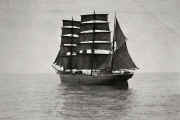 |
| Day
35 Aug 15th |
At sea, overcast. A few flying-fish only. Hot, but a cool breeze sprang up in the evening for a while, calm and only slight pitching. Some rain at night |
| Day
36 Aug 16th |
At sea – overcast for part of the day. Breeze slightly cooler.. |
| Day
37 Aug 17th |
Crossed the northern Tropic-line in the afternoon. Overcast with sunny intervals most of the day. Still very hot, but breeze cooling a little. Very few flying fish. |
| Day
38 Aug 18th |
At sea – Sun very hot during morning. Fine mostly all day. Much cooler in evening. |
| Day
39 Aug 19th |
At sea, cooler, though sun very hot, good N.E. breeze making ship pitch a good deal. Large petrels (dark above, white below) becoming numerous; also flying-fish. Some engine-room damage caused several hours’ delay, the ship going dead slow. Repairs were effected, full speed was regained. |
| Day
40 Aug 20th |
Very cool in early morning. Madeira sighted at about 9 am. We anchored off Funchal at 11.30 am. Many gulls and petrels. A mist hung over the island. I stayed on board for lunch and went ashore with Bryant and Gutteridge, bought some embroideries (Tenerife work). We went to the public garden and spent a little time there. The sea was choppy and landing from the launch rather difficult, as also getting on board from the launch. Weighed anchor at 4 pm. I got letters from home for the first time during the voyage. It was very cold for a few hours after leaving Funchal and passing the Desertas, turning warmer later. |
| Day
41 Aug 21st |
At sea. Calm. A few petrels or large shearwaters. Nothing else. |
| Day
42 Aug 22nd |
Very still and calm. Ran into a fog-belt at about 7 a.m, but it did not last long. I saw a good-sized shark in the still water outside the Tagus Estuary. Entered the Tagus at about 10.30 a.m. The clock was put on 1hr and 40 minutes, to take up "Summer time", so that the time was really 12.10. We anchored off Lisbon. I went ashore by myself to see the archaeological collection in the Museum at the Academia Real das Sciencias. Stone age collections very interesting. I went on to the Botanic Garden, which is extensive and well organised with labels. I returned on board at 5 p.m. with the others who had gone ashore on various excursions. The ship did not sail till 7 p.m. The day was very hot and I was tired, having been on my legs all the time ashore. Very still, fine evening. The late sunset was nice, after weeks of sundown soon after 6p.m. |
| Day
43 Aug 23rd |
We reached Leixões at about 10 a.m. and anchored in the harbour. Rather foggy. There was a great crowd at the landing beach for fishing-boats, where the boats were arriving with their catches. Some of the local small boats have very high sterns and are rather striking. I went ashore with Dr. Atock, Stewart and Mrs Pollock, we were shown round Leixões by a guide, who was interesting. We saw the quaint and rather tawdry church. There was not very much time as the ship was sailing fairly soon, we returned on board after about 1 1/2 hours.Passing the northern lights of Spain at 10.30 pm. Rather cold. |
|
| Day
44 Aug 24th |
At sea. The Bay of Biscay behaving very well. Fine day with good breeze on port side, a fair amount of pitching. Later the sea turned a bit rough and the wind was very cold. Many passengers laid out. Too chilly to stay on deck in the evening. | |
| Day
45 Aug 25th |
At sea the Bay was rough all through the night and it was very cold. Passed the Bishop Rock Lighthouse, at S.W. end of the Scilly Islands. early in the morning. In the afternoon the sea became perfectly calm and the wind dropped. Passed close to Grasholm and I could see very clearly the great white patch of the nesting area of Gannets. Skomer Island was well in view in the background ( I could see the farm-house upon it quite clearly with glasses). The Wicklow hills showed up distinctly on the port beam. The stack lighthouse abeam at about 11.30 pm. | |
| Day
46 Aug 26th |
Arrived in the Mersey very early in the morning and tied up to the quay at about 7.0 a.m. Went ashore with "Marocas" in a large cage-box, made by the ship’s carpenter. After clearing the customs, I went over to Birkenhead and caught the 9.35 am. train to Oxford, arriving at 2.18 p.m. Was met by E. and the Twins. |